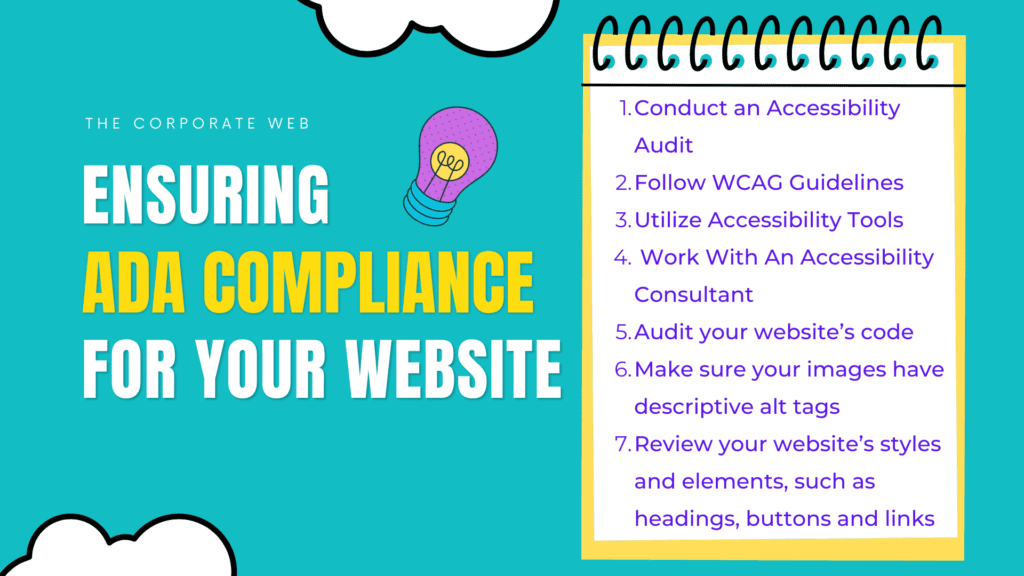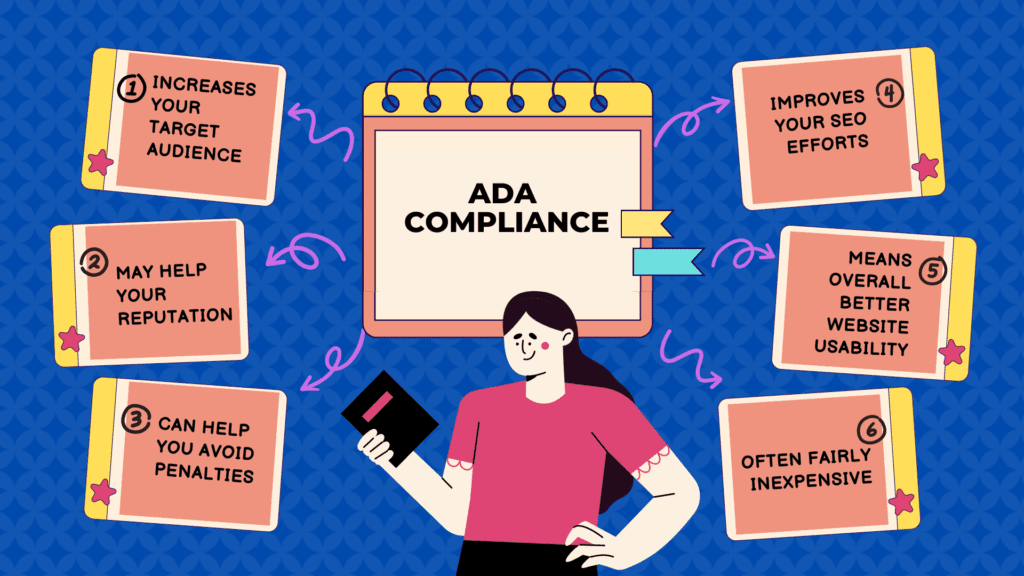As more businesses shift their focus to online marketing, the importance of accessibility in digital marketing has become increasingly apparent. In order to ensure that their websites are accessible to all users, businesses must ensure that they are ADA compliant.
The Americans with Disabilities Act (ADA) is a federal law that requires businesses to provide equal access to individuals with disabilities, including access to their websites. In this blog post, we will explore why your website needs to be ADA-compliant and provide a guide to accessibility in digital marketing.
What is ADA Compliance?
ADA compliance refers to ensuring that individuals with disabilities have equal access to public accommodations, which includes businesses that operate online. The ADA was enacted in 1990 to prevent discrimination against individuals with disabilities and to provide equal opportunities for participation in society.
While the ADA was originally focused on physical accommodations, such as wheelchair ramps and accessible restrooms, the law has been updated to include digital accessibility as well.
Why is ADA Compliance Important for Digital Marketing?
There are several reasons why ADA compliance is essential for digital marketing. First, it is the law. Failure to comply with ADA regulations can result in costly fines and legal action. In addition, ADA compliance is essential for ethical reasons.
By making your website accessible to individuals with disabilities, you are demonstrating your commitment to providing equal access and promoting inclusivity.
Another important reason why ADA compliance is important for digital marketing is that it can have a significant impact on your website’s SEO. Google, the world’s largest search engine, has stated that accessibility is a key factor in search engine rankings. In other words, if your website is not accessible, it is less likely to appear in search engine results, which can hurt your visibility and traffic.
Furthermore, creating an accessible website can improve the overall user experience for all users. For example, individuals with visual impairments may use screen readers to navigate websites, while individuals with mobility impairments may use assistive technology to control their computers. By ensuring that your website is accessible to these users, you are providing a better user experience for everyone.
What Are the Key Elements of ADA Compliance?
There are several key elements of ADA compliance that businesses should consider when developing their websites. These include:
1. Alternative Text for Images
Alternative text, also known as alt text, is a description of an image that is read by screen readers for individuals with visual impairments. Including alt text on all images on your website is essential for ensuring that users with disabilities can understand the content of the image.
2. Captions and Transcripts for Videos
Captions and transcripts are essential for individuals who are deaf or hard of hearing. By including captions and transcripts for all videos on your website, you are ensuring that these users can access the content.
3. Keyboard Navigation
Keyboard navigation is essential for individuals who are unable to use a mouse. By ensuring that your website can be navigated using only a keyboard, you are providing equal access to these users.
4. Color Contrast
Color contrast is important for individuals with visual impairments, as it can affect their ability to read text. By ensuring that the color contrast on your website meets the Web Content Accessibility Guidelines (WCAG) standards, you are providing equal access to these users.
5. Headings and Structure
Headings and structure are important for individuals who use screen readers to navigate websites. By ensuring that your website is structured with headings that accurately describe the content, you are providing equal access to these users.
6. Forms
Forms should be designed with accessibility in mind, including the use of labels and clear instructions. By ensuring that your records are accessible, you are providing equal access to individuals with disabilities who may need to use them.
7. Website Accessibility Statement
A website accessibility statement declares that your website is designed to be accessible to all users, including those with disabilities with information about the importance of ADA compliance and how it can benefit your business. This statement can help build trust with potential customers and demonstrate your commitment to inclusivity.
How Can You Ensure Your Website is ADA Compliant?

Ensuring that your website is ADA-compliant can seem like a daunting task, but there are several steps you can take to make your website more accessible. These include:
1. Conduct an Accessibility Audit
The first step in ensuring ADA compliance is to conduct an accessibility audit of your website. This can help you identify areas of your website that may be inaccessible and provide a roadmap for making improvements.
2. Follow WCAG Guidelines
The Web Content Accessibility Guidelines (WCAG) provide a set of standards for ensuring that websites are accessible to individuals with disabilities. Following these guidelines can help ensure that your website meets the minimum requirements for ADA compliance.
3. Utilize Accessibility Tools
There are several tools available that can help you test the accessibility of your website, including screen readers, color contrast analyzers, and keyboard testing tools. These tools can help identify areas of your website that may need improvement.
4. Work with an Accessibility Consultant
If you are unsure how to make your website more accessible, consider working with an accessibility consultant. These professionals can provide guidance and support to help you ensure that your website meets ADA compliance standards.
Conclusion
ADA compliance is an important consideration for businesses that operate online. By ensuring that your website is accessible to individuals with disabilities, you are promoting inclusivity and demonstrating your commitment to providing equal access. In addition, ADA compliance can improve your website’s SEO and provide a better user experience for all users.
While achieving ADA compliance may require some effort, the benefits are well worth the investment. By following the guidelines outlined in this guide, you can help ensure that your website is accessible to all users, regardless of their abilities.
Read More: The Ultimate Guide To Social Media Advertising For Small Businesses
FAQs Related To ADA Compliance
What is ADA compliance?
ADA compliance refers to ensuring that individuals with disabilities have equal access to public accommodations, which includes businesses that operate online.
Why is ADA compliance important for digital marketing?
ADA compliance is important for digital marketing for several reasons, including legal compliance, ethical considerations, and improved SEO and user experience.
What are the key elements of ADA compliance?
The key elements of ADA compliance include alternative text for images, captions, transcripts for videos, keyboard navigation, color contrast, headings and structure, forms, and a website accessibility statement.
How can you ensure your website is ADA-compliant?
You can ensure that your website is ADA-compliant by conducting an accessibility audit, following WCAG guidelines, utilizing accessibility tools, and working with an accessibility consultant.
What are the benefits of ADA compliance for businesses?
The benefits of ADA compliance for businesses include improved SEO, increased visibility and traffic, a better user experience for all users, and demonstrating a commitment to inclusivity and ethical business practices.
Read More: How to Make Your Website ADA Compliant






